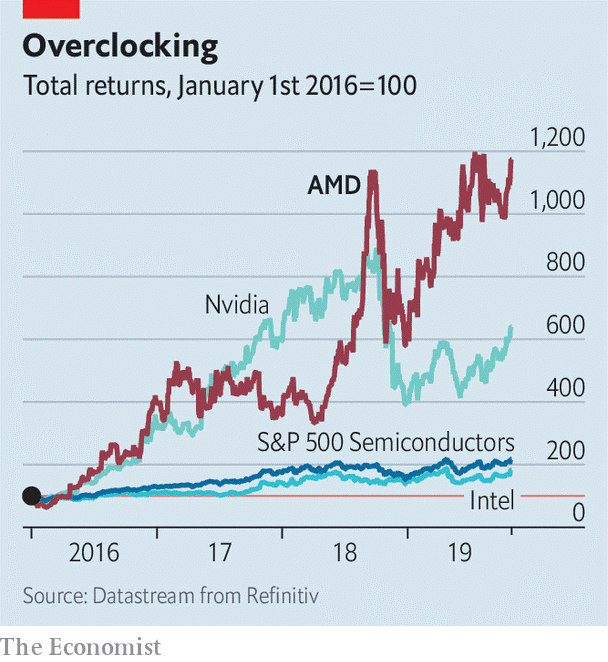

 字體:小 中 大
字體:小 中 大 |
|
|
|
| 2019/11/20 17:45:40瀏覽220|回應0|推薦0 | |
這篇是在英特爾的第十代處理器問市後,經濟學者雜誌以各龍頭國際晶片大廠五年股價走勢為背景,很高興於處理器廠牌間的提升競爭力,尤以超微半導體公司AMD擺脫四年前業務急速萎縮(一度盛傳倒閉)的奇蹟。在本月(2019年第四季)問市的產品,有微軟的Surface、聯想電腦和台灣的ACER、ASUS都有推出新一代的AMD機種。AMD從2014年10月以來,由台南市出生的蘇姿豐女士(業界綽號蘇媽,Lisa Su,三歲起移民美國,為麻省理工學院電機博士),擔任CEO兼總裁。(見經濟學者報導正文下面的PCWorld舊資料文章)。 本篇並附最新及最頂級的Ryzen系列的處理器Ryzen 9 3950 介紹和測試影片聯結。這一季可熱鬧了,雖然筆者沒有辦法親自在終端市場參與,AMD 第三代 mobile Ryzen 系列和Intel 以i7-1068G7領軍的第十代處理器,Qualcomm Snapdragon 8cx和 ,並列三個2019的三大處理器。Intel的處理器改革處理器的方向仍然是低功耗(最小9瓦)、性價比試圖提高、集成顯卡的支援更大(內顯的能力九至十代有更好)、效能提升更快,但算起來桌機版的第十代和第九代,明顯於低功耗外(與第九代者同價位的第十代文書機種較有性價比變優的感受度),其他的進步幅度不多。
The Zen masters AMD, a chipmaking underdog, is having its day And nipping at Intel’s heels
Oct 31st 2019 DAVID, HE OF the spat with Goliath, is an overused corporate analogy. But it is hard to think of a more appropriate one for Advanced Micro Devices (AMD). On October 29th the American chipmaking tiddler reported its third-quarter results. Lisa Su, its boss, declared herself “extremely pleased”. No wonder. At $1.8bn, revenue was the highest since 2005. AMD predicted that next quarter’s figures would be equally perky, up 48% on the previous year to $2.1bn. Its share price has risen 15-fold since 2015 (see chart). AMD is more important to the chip business than its diminutive stature suggests. It provides the only meaningful competition to not one but two Goliaths in two important parts of the semiconductor industry. Its CPUs—the general-purpose chips at the heart of modern laptops, desktops and data centres—compete with those from Intel, whose $71bn of revenue in 2018 made it the world’s second-biggest chipmaker. Its GPUs—which provide 3D graphics for video games and, increasingly, the computational grunt for trendy machine-learning algorithms—go up against those from Nvidia, whose revenues last year of $11.7bn were nearly twice those of AMD.
AMD’s purple patch comes mostly from its battles with Intel. Until recently, Intel virtually monopolised the CPU market. Analysts at Mercury Research reckon that in 2015 its chips accounted for 92.4% of desktop and laptop computers, and 99.2% of the more lucrative market in server chips. Mercury’s most recent numbers put AMD’s share at 14.7% for desktops and laptops. For servers it is a more modest 3.1%—but still five times what it was two years ago. Two things explain the firm’s resurgence. One is a better product. In 2012 AMD rehired Jim Keller, a well-regarded chip designer who had been at Apple. AMD had long been competing on price—its chips were slower than Intel’s but much cheaper. Mr Keller’s “Zen” chips, unveiled in 2017, are still cheap. But they are now as zippy as Intel’s, or even zippier: AMD’s top-end server chip, for instance, is faster than its Intel counterpart in many tasks, and costs half as much. Zen chips have won a string of contracts with Microsoft and Sony (for new games consoles), Google (data centres) and Cray (supercomputers), among others. The second reason is that, while AMD has improved, Intel has stumbled. The firm makes its own chips. Its latest and greatest manufacturing process, which should have delivered a big performance boost, is years late, leaving the firm to rehash existing designs. AMD contracts most of its manufacturing to the Taiwan Semiconductor Manufacturing Company, which has now caught up with Intel’s technology. Can AMD’s good fortune last? Intel eventually put paid to similarly competitive spells at the turn of the century and in the mid-2000s. It is trying again. In 2018 it hired Mr Keller, this time from Tesla (he had left AMD in 2015). It plans to launch an advanced new manufacturing process in 2021. A planned move into GPUs could squeeze AMD from another direction. For now, AMD’s resurgence is good news for consumers, IT departments, cloud-computing firms and anybody who uses software. Like any good monopolist, Intel charges a steep price for its products—unless AMD is doing well. Sure enough, Intel’s newest set of desktop chips, due in November, are some of its thriftiest in years. ■ This article appeared in the Business section of the print edition under the headline "The Zen masters" ============================= 以下是PCworld的聯結及舊資料文章 Special edition: AMD talks 3rd-Gen Threadripper and Ryzen 9 3950X | The Full NerdPCWorld | Nov 12, 2019 In todays special episode we are joined by AMDs Senior Technical Marketing Manager Robert Hallock to talk about 3rd Gen Threadripper launch details and Ryzen 9 3950X. (以下為影片連結) https://www.pcworld.com/video/99327/special-edition-amd-talks-3rd-gen-threadripper-and-ryzen-9-3950x-the-full-nerd
AMD unveils 32-core Threadripper 3970X, 16-core Ryzen 9 3950X, and unlocked AthlonThe 32-core Threadripper will cost $1,999, and therell be a 24-core Threadripper for $1,399, too.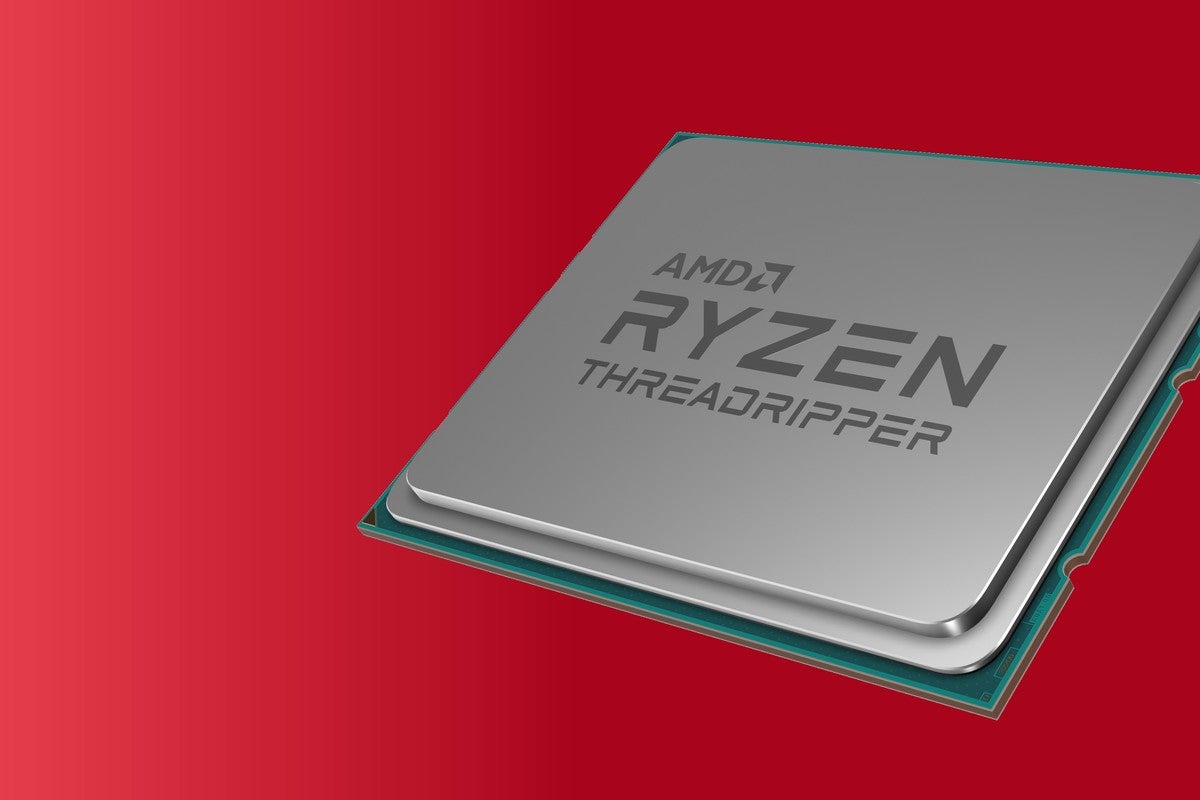 AMD AMD AMD on Thursday officially unwrapped two new Threadripper 3 CPUs with 24 and 32 cores, respectively. The company also announced an unlocked Athlon and said its 16-core Ryzen 9 3950X will finally go on sale on November 28. The two new Threadripper CPUs are the biggest news. AMD will sell a 24-core Threadripper 3960X for $1,399. The chip is built on a 7nm process, features 140MB of cache, and will have a base clock of 3.8GHz and boost of 4.5GHz. The 32-core Threadripper 3970X, priced at $1,999, arrives in the wake of much undue hand-wringing that AMD would only go to 24 cores. Both CPUs will go into AMD’s new TRX40 platform using the new sTRX4 socket. The use of a new socket essentially means the original X399 chipset, along with the Threadripper 2000-series, will be stranded.
Insane amounts of PCIe lanesThe consolation may come with an insane amount of PCIe bandwidth. AMD said up to 72 lanes of PCIe are available in the new platform. The block map the company showed off indicates 48 PCIe 4.0 lanes can be dispersed for general use. Another pair of x4 PCIe 4.0 can be used for NVMe, or broken up as two quad-clusters of SATA ports. With the chipset connection at a beefy 8 lanes of PCIe 4.0, you get up to 64 from the CPU. Much of that sounds the same as the previous X399, which also featured 64 PCIe lanes off the CPU. The key difference here is PCIe 4.0, which doubles bandwidth over PCIe 3.0. The other difference is additional PCIe 4.0 lanes in the chipset. AMD’s block map shows 8 lanes of PCIe 4.0 off the TRX40 chipset for general use, and 8 more lanes of PCIe 4.0 that can be split off. That’s basically 72 total—AMD touts “88 lanes” of PCIe, but that’s only if you count the reserved lanes for chipset communication. Quad-channel RAM stays putThe amount of memory channels for the new Threadrippers also appears unchanged, with up to four channels of DDR4 supported on both CPUs. While there had been speculation that AMD would go with an eight-channel memory configuration to coincide with an expected 64-core CPU, AMD didn’t say peep about additional memory channel support (which would require an additional new platform) or a new CPU. So for now, Threadripper sticks with quad-channel memory. 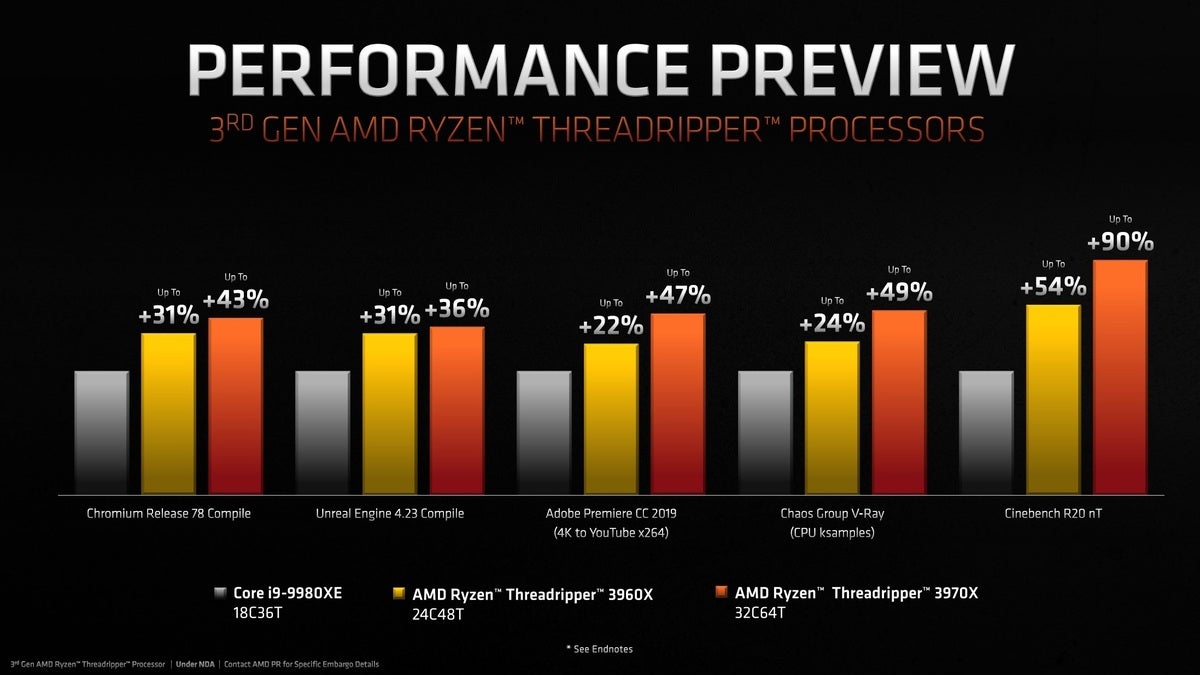 AMD AMD
AMD will flex its core count muscles with Threadripper 3000. AMD says itll be fastAMD has long had a core count advantage over Core i9, but with the new, more efficient Zen 2 cores in the Threadripper 3000 chips, the company also promises a lot more performance. For example, AMD said its 32-core Threadripper 3970X will be up to 90 percent faster in Cinebench R20 over an 18-core Core i9-9980XE. The 24-core will outpace Intel’s current best Core i9 by 54 percent, the company added. AMD also claims a huge advantage over the top-end Skylake-X chip in Chromium compiles, Unreal engine compiles, Adobe Premiere CC encodes and Chaos Group’s V-Ray renderer. The Core i9-9980XE isn’t Intel’s top prosumer chip, though. The company announced its new Core i9-10980XE at crazy-low prices in early October. While the older 18-Core i9-9980XE still sells for $1,919 today on Amazon.com, the new 18-core Core i9-10980XE will sell for $979. In a strange turn of events, with Intel’s crazy price cuts in place, AMD’s new Threadripper will actually occupy the higher ground on pricing. If you use the overly simplistic metric of dollar per thread, Intel actually has an advantage in a Core i9 vs Threadripper price match. Of course, from AMD’s point of view, it probably thinks Core i9 can’t even hang with its Threadripper anymore and would rather see its $750 16-core Ryzen 9 3950X duke it out with Core i9 today.  IDG IDG
Intel oddly almost has a price advantage. Ryzen 9 3950X: Coming soon, with Eco ModeHeres the other big announcement: The long-awaited, slightly delayed 16-core Ryzen 9 3950X will go on sale on November 25, the company said. Pinkie-swear. The CPU had been expected in September, but was pushed back to November. AMD has taken that time to add feature called Eco Mode. 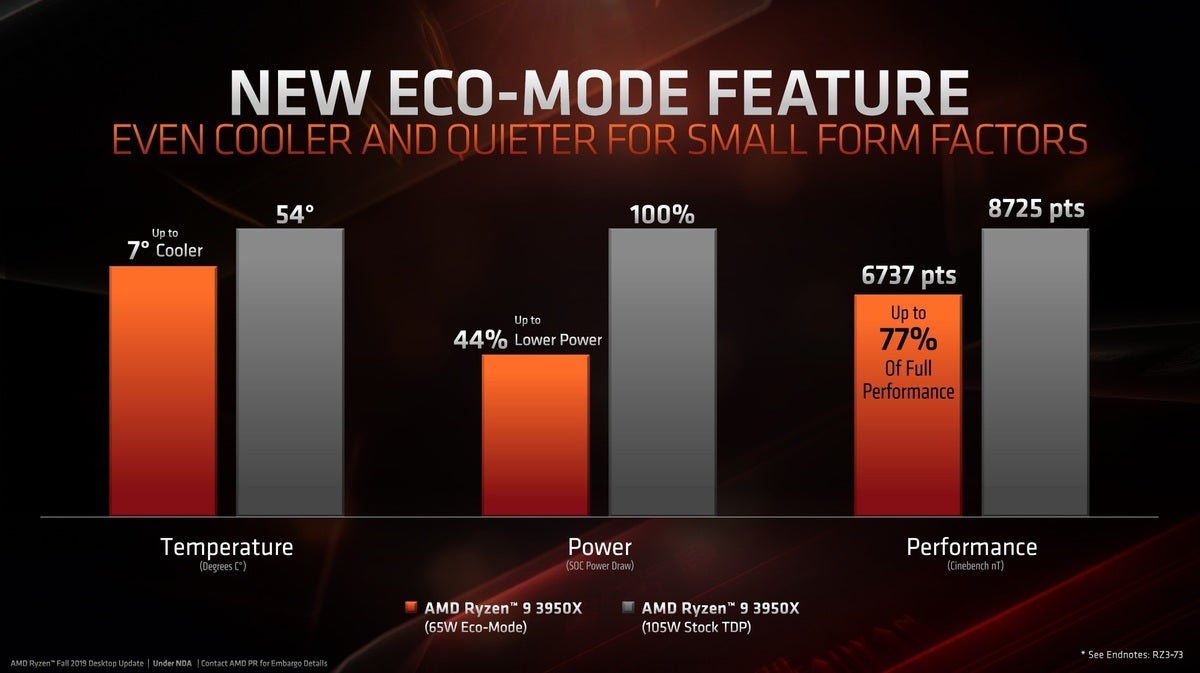 AMD AMD
Eco Mode gets you 77 percent the performance of the CPU at 44 percent of the power consumtion of the standard mode. Eco Mode will let you scale the CPU back from its rated 105-watt TDP to 65 watts. There is a performance cost: AMD said Eco Mode will get you about 77 percent of the performance of the standard mode, but at 44 percent of the power consumption and also about 7 percent cooler. AMD said Eco Mode can be turned on and off from within a new version of the Ryzen Master utility. The company said the mode was added by request from users who want to use Ryzen CPUs inside home theater PCs and other environments with limited thermal and noise headroom. AMD is casting a wide net, saying the new Eco Mode will apply to other 105-watt Ryzen-based chips. Eco Mode will also allow 95-watt chips to drop to 65 watts, and 65-watt CPUs to drop to 45 watts. AMD took the opportunity to drop more hints about how much of a thrashing the CPU will give to its competitors. Of course, the comparison is fairly close against Intel’s $500, 8-core, Core i9-9900K, but AMD said it’ll thrash the 12-core Core i9-9920X, which sells for $1,000. 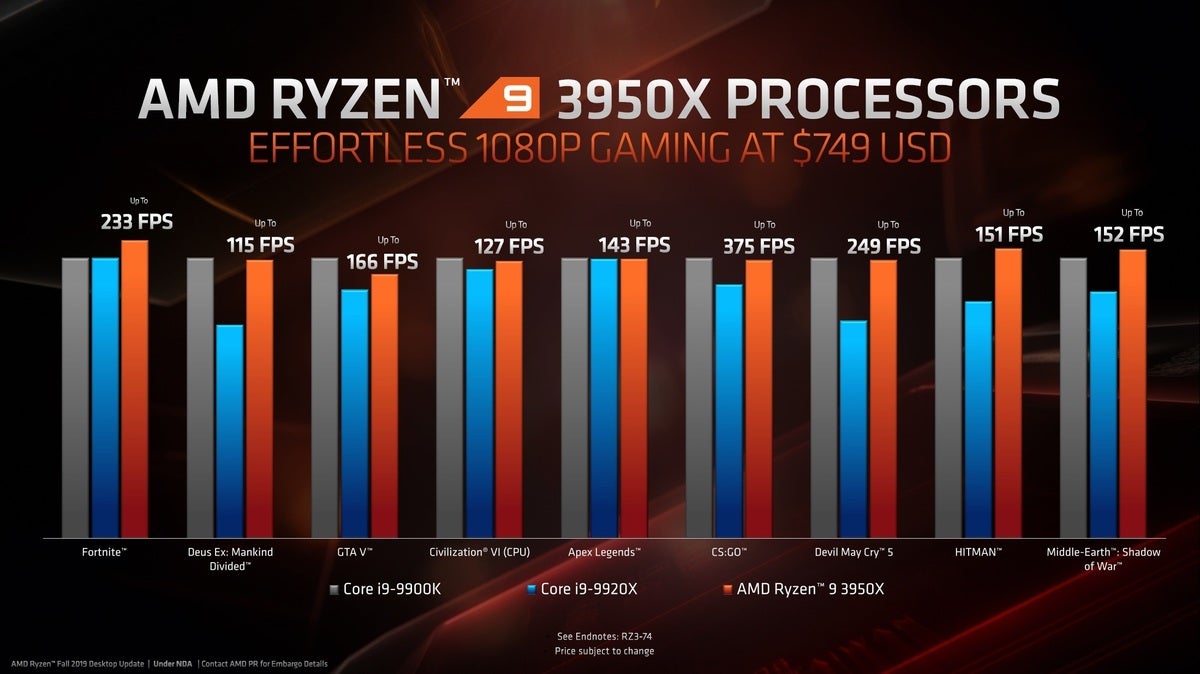 AMD AMD
According to AMD, the Ryzen 9 3950X will outrun the Core i9 in some games. Content creation will be the 16-core Ryzen 9 3900Xs forte. The $500 Ryzen 9 3900X already had the Core i9-9900KS on the ropes for multi-threaded and most content creation tasks, so the 16 core? Yeah, it’s just a victory lap at this point for AMD. 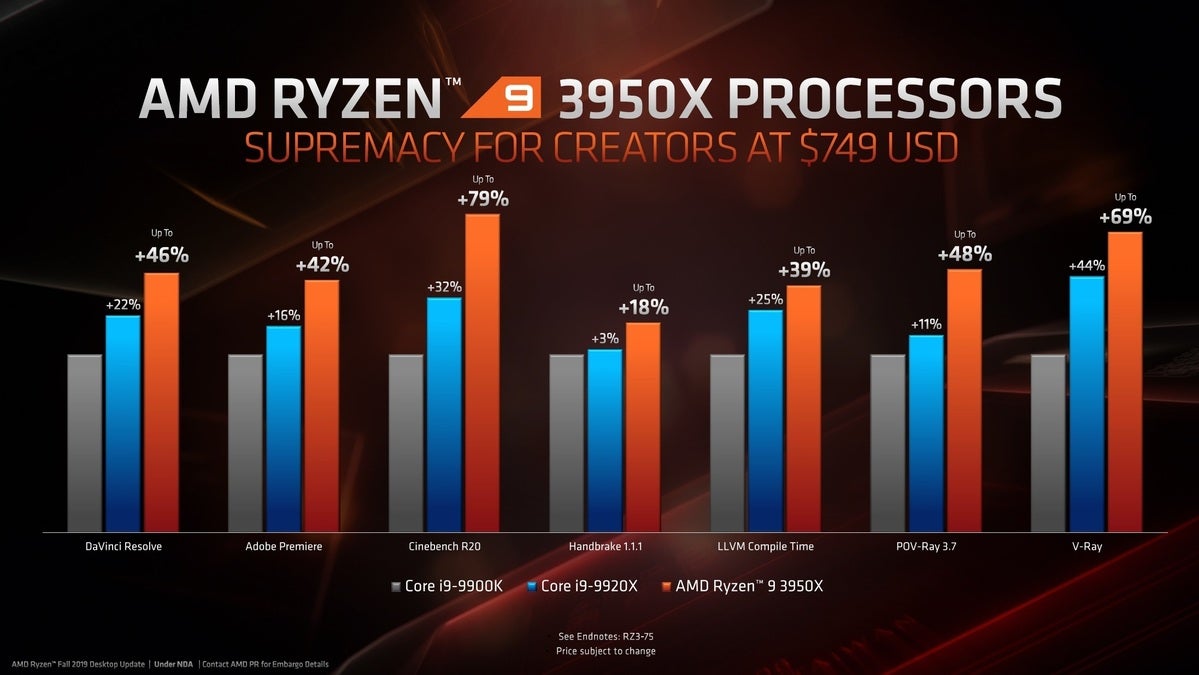 AMD AMD
Content creation though, is a cake walk. An overclockable Athlon, tooNot everyone can afford a $2,000 32-core Threadripper 3970X or a $750 Ryzen 9 3950X, so AMD is throwing budget PC users a bone: an overclockable Athlon 3000G. The Athlon 3000G will feature two cores with symmetrical multi-threading, and Radeon Vega 3 graphics, for $50. The chip will have a clock frequency of 3.5GHz and, yes, you can overclock it. AMD envisions the Athlon 3000G going up against Intel’s $60 dual-core Pentium Gold G5400. Although AMD didn’t detail its architecture, the Athlon 3000G is likely a Zen+ chip built on a 12nm process. That’s still enough, AMD claims, to put it ahead of the Pentium Gold G5400. AMD said its tests show the Athlon outperforming the Pentium in boring desktop use, and easily outrunning the Pentium Gold in gaming. AMD said the new Athlon 3000G will go on sale November 19. 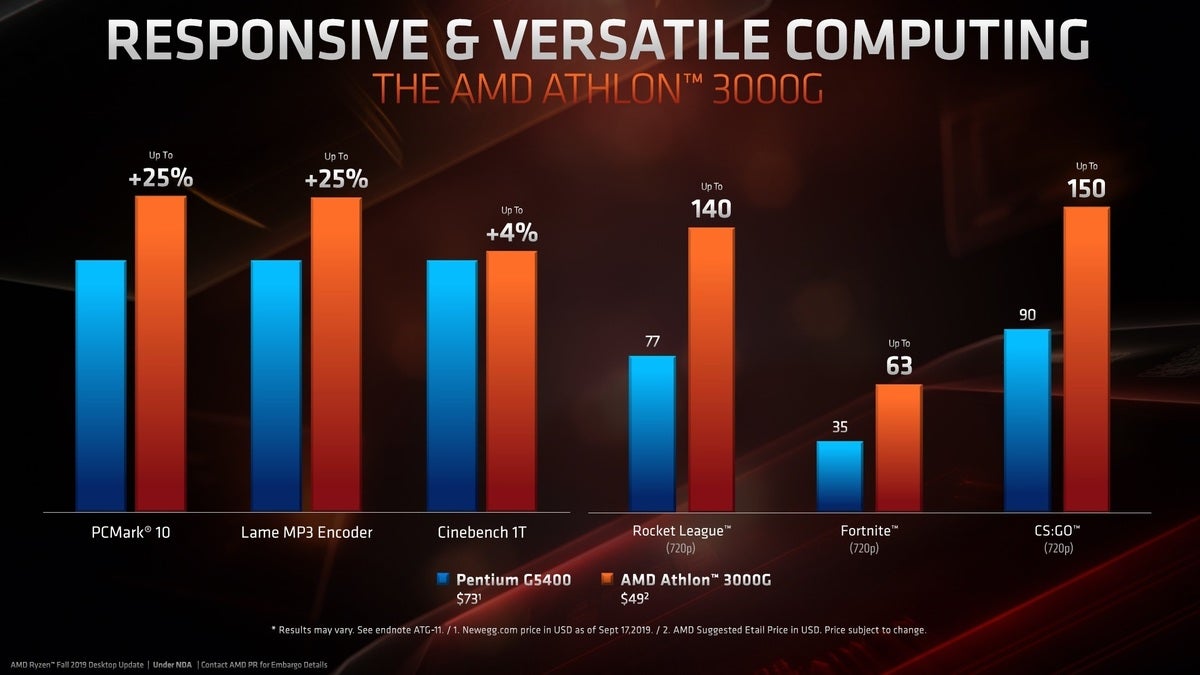 AMD AMD
Note: When you purchase something after clicking links in our articles, we may earn a small commission. Read our affiliate link policy for more details.
AMD names Lisa Su to replace Rory Read as CEO, continue diversification strategy AMD AMD Struggling microprocessor maker Advanced Micro Devices said Rory Read, its chief executive, had stepped down and will be replaced by Lisa Su, the companys chief operating officer, effective immediately. The company said that the transition was part of a succession plan that Read and the companys board had developed together. In a somewhat unusual move, Read appeared with Su on a conference call announcing the transition. "Shes a semiconductor professional," Read of Su. "She loves this space. She knows this space." Read praised Su extensively, saying that AMD had hired Su, trained her, and apparently groomed her for the position. Shes the "right leader" for AMD, he said, and is uniquely positioned for the job, he said. ThatAMD] forward," Read said. Read will remain on at AMD as a consultant.
Former CEO Rory Read stabilized AMD, but the companys growth has been sluggish. Why this matters: AMD is the only remaining challenger to Intels total domination in the x86 microprocessor market. A strong, viable, AMD benefits competition in the PC space. Su is well respected in the industry, and the handoff from Read to Su was unusually chummy. Heres the billion-dollar question, though: Can Su resuscitate AMD, however, or will it fade away to become just another Via Technology? AMDs console wins keep it afloatAlthough AMD has won fans for its microprocessors and graphics, the companys performance has slipped. AMDs share of the x86 PC microprocessor market has fallen to less than 20 percent. Under Read, the company has diversifed into semi-custom chips, servers, and designs that use third-party ARM cores. AMDs semi-custom business has been successful, as the company supplies the chips to all three major game consoles. Read returned AMD to profitability, although the companys most recent earnings fell just short. [ Further reading: The best CPUs for gaming ] "I give Rory Read credit for stabilizing the company during a time where the PC market tanked, but AMD needs growth now more than ever," Patrick Moorhead, a former AMD fellow and now an independent analyst, said in an email. "Lisa is respected in the industry and I think she will bring a new look that will be welcomed." Read had talked about a three-phase process: Resetting the companys business, restructuring it, and then moving forward to a third stage. Su said that third stage involves making the "right technology investments," which will involve streamlining the companys product line, but also continuing the emphasis on diversification. "I do think moving forward its about technology and how we accelerate the technology," Su said during the conference call. Su said there was no way that AMD would exit the x86 microprocessor space, and that ARM and the x86 lines would coexist going forward. The PC business will continue, but AMD also planned to grow the embedded, enterprise, and semi-custom space. "I think we want to simplify the company," Su said, improving the companys time to market. One of the steps Su said she hopes to take was to nail down relationships with specific customers. Several analysts were concerned about the timing of the announcement, given the fact that AMD is set to announce its quarterly earnings next week. Read said that the company had a "fiduciary duty" to report now, rather than waiting. Note: When you purchase something after clicking links in our articles, we may earn a small commission. Read our affiliate link policy for more details.
====================== PCWorld在8月1日發佈了英特爾確定要在下一季推出的第十代處理器的消息,並公佈處理器的官方售價。代碼方面,"5"是指第八代及修正八代的U,在想要低功耗和想要高效率之間取得平衡,"0"取代了低電壓版而高效率的Y系列。 (https://www.pcworld.com/article/3411974/intel-10th-gen-ice-lake-chips-specs-features-pricing-availability.html?fbclid=IwAR0JMi8gMXix8HKN-FEFmadgUDb_EoSp-EnZUHjCDiVxqfSzuaolYdkUWRU) Intel launches 10th-gen Ice Lake chips, pushing hard on graphics for notebook PCsIn addition to its new Ice Lake chips, Intel says that a new, higher-frequency Core chip will be announced near the end of August.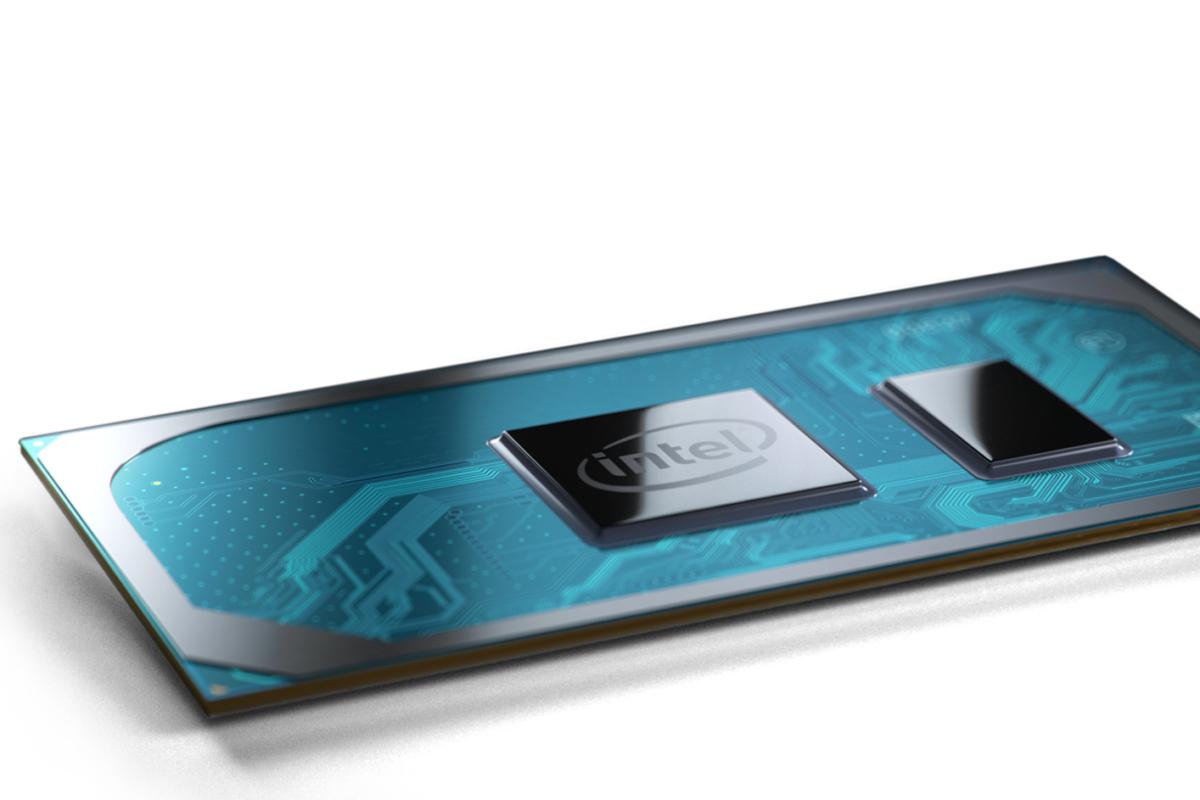 Intel Intel Intel’s eleven new Ice Lake chips are betting big on graphics. Intel claims that its new 10th-gen Core family, launched Thursday, will offer the best integrated graphics experience of any thin-and-light notebook PC—about equaling what some discrete chips offer in PCWorld tests. Intel began setting up Ice Lake expectations in May, positioning its first mass-market 10nm parts as improvements for the notebook PC as a whole, including AI, communications, and I/O. The overarching message is “new:” a new process technology, a new CPU core, and a new graphics engine, along with “new” advancements in communications and I/O. Here are Intel’s mobile Ice Lake chips, in a nutshell: 11 processors, most sporting 4 cores and 8 threads, in either a 9W, 15W, or 28W power tier. Base frequencies begin at 700MHz and climb to 2.3GHz, while single-clock turbo frequencies top out at 4.1GHz. Graphics frequencies will hover right around 1GHz, with 32, 48 and 64 EUs differentiating performance. We also have real-world testing data to demonstrate how Ice Lake delivers graphic performance on a par with the lowest tier of discrete GPUs. 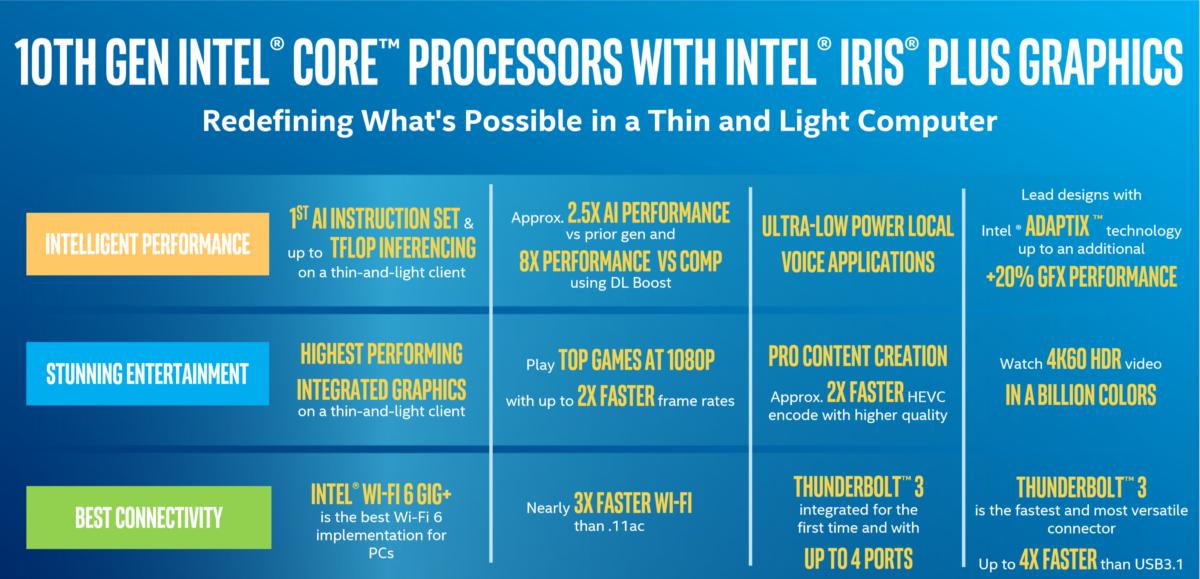 Intel Intel
Ice Lakes "sizzle reel:" everything that Intel believes that Ice Lake can offer, along a number of performance axes. A bit of sticker shock, however, may affect how some perceive Ice Lake. Most 10th-gen Ice Lake base clock speeds fall short of their existing 8th-gen Whiskey Lake counterparts. Some of the new Ice Lake low-power chips offer base clocks of less than 1GHz. Versions of Ice Lake designed for tablets now consume 9 watts, rather than the 5 watts of their predecessors, Amber Lake. Intel says that more than 35 notebooks built around Ice Lake microprocessors will be sold alongside existing Whiskey Lake and Amber Lake notebooks, beginning this holiday season. There’s still more to come: Intel’s next microprocessor disclosure will be made in the second half of August, where the “second part of our mobile family” will target “high-frequency applications” and form the foundation for Intel’s commercial offerings, said Ran Senderowitz, vice president of mobile platform marketing for Intel’s Client Computing Group. Will that be Intel’s next-gen Tiger Lake chip, due in 2020? Or the Comet Lake chip that was part of a recent leaked roadmap? Things are getting messy. 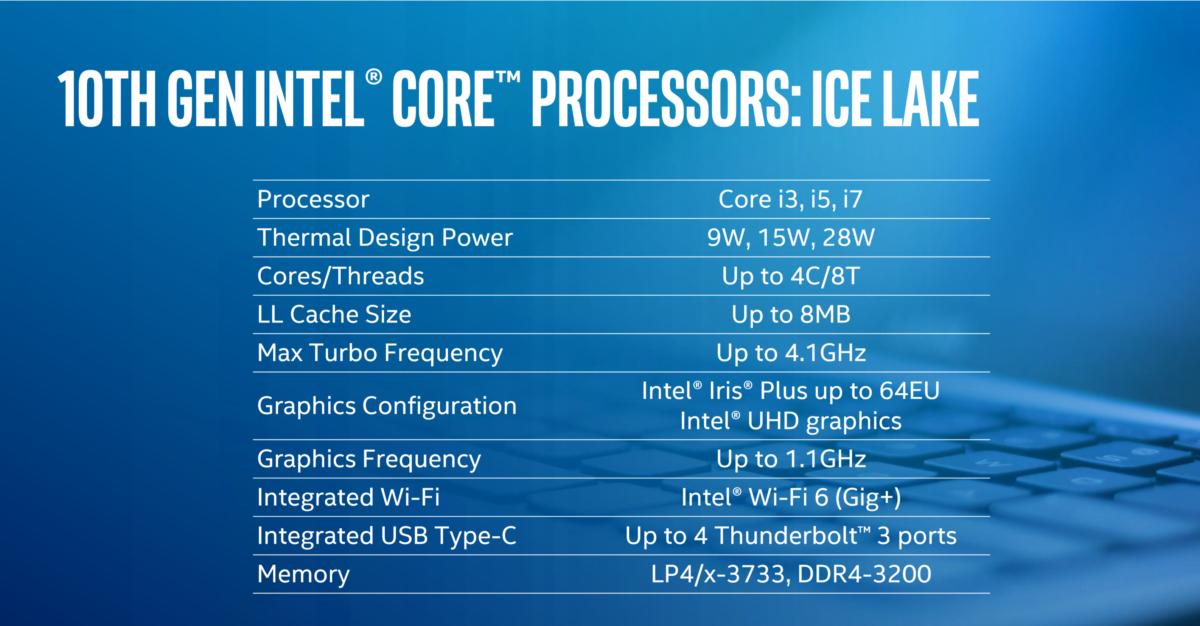 Intel Intel
The basic specifications of Intel’s Ice Lake processor, summed up. Table of Contents
How to read Intel’s new Ice Lake model numbersIntel is promising to ship new products to every PC segment over the next 12 months—nothing particularly new, as product refreshes occur throughout the year. But with a mixture of 14nm and the new 10nm products co-existing in the market, things may get confusing—especially with Qualcomm’s Snapdragon 8cx and AMD’s third-gen mobile Ryzen chips also in play. [ Further reading: The best CPUs for gaming ]Before you can parse Intel’s new Ice Lake products, however, you’ll need to describe them—and yes, Intel has a new model number scheme, too. Intel still offers Core i3, i5, and i7 processor families, differentiating their good-better-best status. Each Ice Lake model number also begins with a 10 prefix to designate its 10th-generation status. Now, however, there are good-better-best suffixes, too: the G1, G4, and G7 descriptors signal the various tiers of graphics performance, with both the G4 and G7 tiers falling under the Intel Iris Plus branding. Also, Intel has officially done away with the U-series and Y-series labels for notebooks and tablets. Instead, the fourth digit of the model number now designates the power tier: “5” for a U-series chip, and “0” for a Y-series processor. A single 28W (or 8-tier) chip exists: the Core i7-1068G7. Still confused? We’ve boiled it down for you, here: 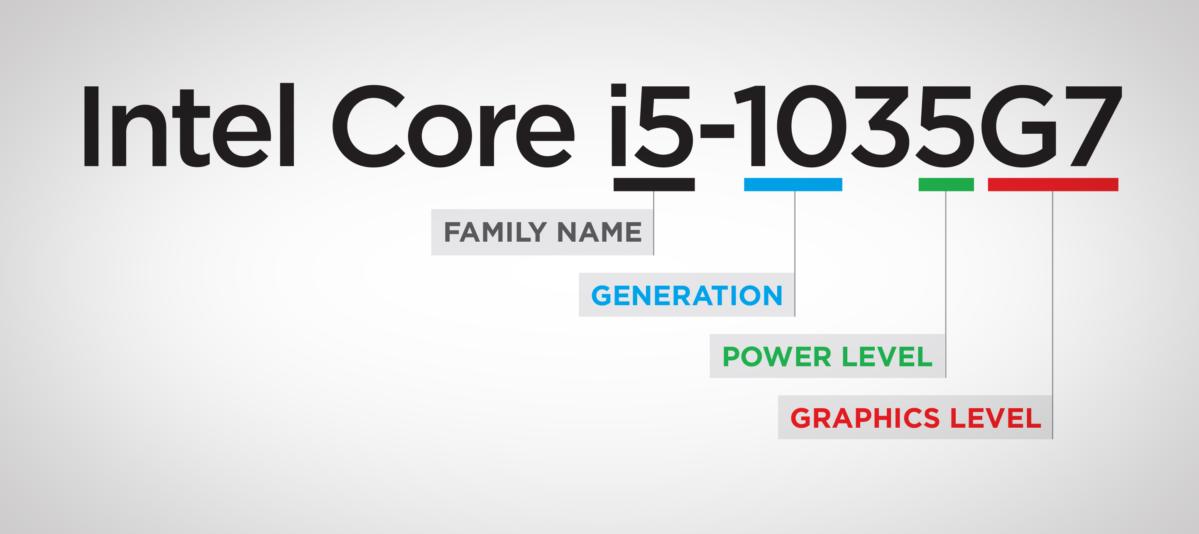 Rob Schultz / IDG Rob Schultz / IDG
Here’s how to make sense of the new Intel model numbers. Intel’s eleven Ice Lake chips, explainedNow that you know what to look for within Intel’s Ice Lake model numbers, here are the eleven new chips. As the slide notes, all of the new Ice Lake processors will include Wi-Fi6 (Gig+) Wi-Fi and Thunderbolt 3 capabilities: four ports this time around, with two ports available on either side of the PC. We go into far more detail in our earlier discussion of the Ice Lake architecture, which is predicated on the Sunny Cove CPU design, a key feature of which is "magic" AI inferencing using Intel’s DLBoost instructions. 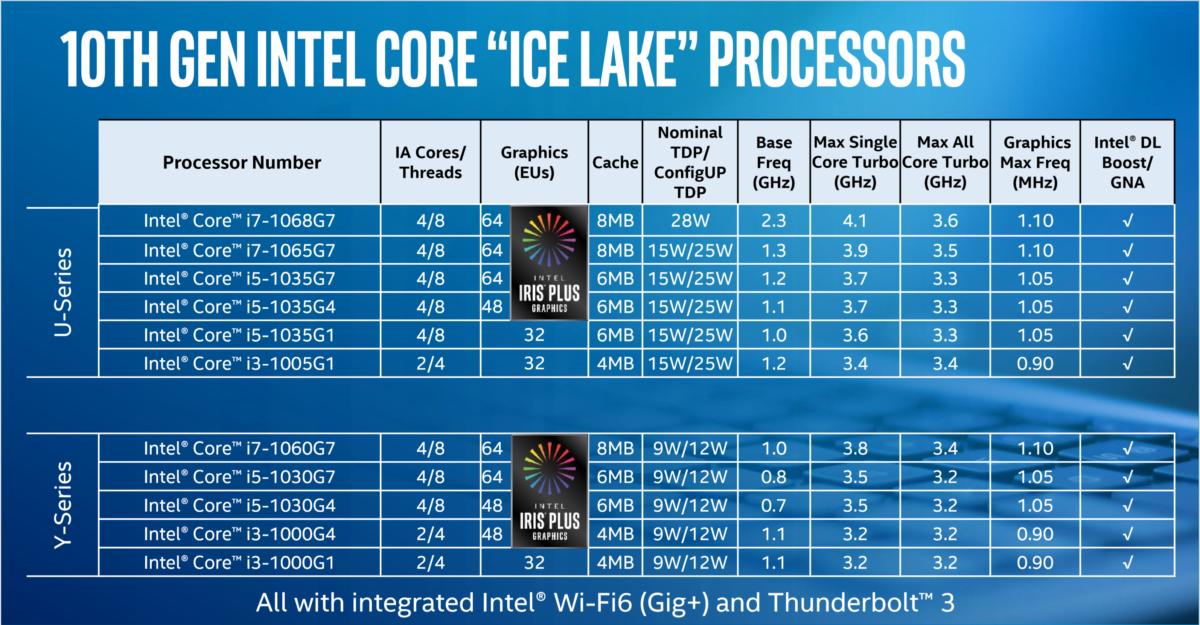 Intel Intel
Intel’s eleven new Ice Lake microprocessors. The ConfigUP TDP numbers indicate that a laptop maker is permitted to power the chip up to the higher rated wattage, to enable additional performance. Battery life can suffer somewhat as a result, however. We also now know that Intel’s Gen11 graphics have three different performance tiers, each with different numbers of EUs: 32, 48, and 64. (EUs are Intel’s programmable shader units, with 3D rendering, compute, programmable and fixed-function media capabilities.) Based on what we’re seeing here, Intel appears to be using the number of EUs as a performance differentiator, rather than the clock speed. Remember, Intel has previously made the claim that Ice Lakes integrated graphics were as good as what AMD offers, keeping pace with the Ryzen 3700U on a variety of different games. According to Senderowitz, Intel won’t be adding to the three EU graphics tiers (at least for now, we can assume). The eleven Ice Lake chips represent the entirety of Ice Lake products that Intel plans to introduce this year, he said. Nevertheless, one of our Ice Lake performance tests shows how well Intels Ice Lake matches up to the downclocked Nvidia GeForce MX100 discrete GPU that was featured in a recent release of an Huawei Matebook. Intels claims that its Ice Lake graphics capabilities equal those of a discrete GPU seem to be borne out. 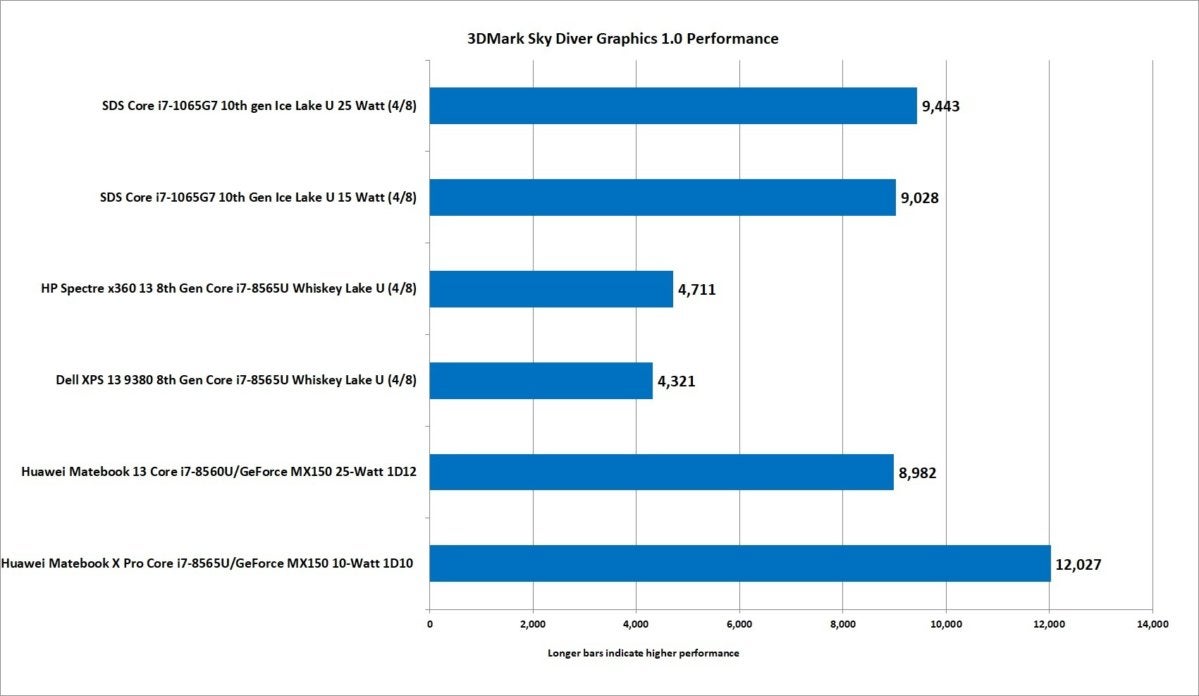 IDG IDG
Note that Huawei used two versions of the GeForce MX100 discrete GPU in successive Matebook notebooks; the slower chip was used in the Huawei Matebook X Pro. While we dont know what Intel will be charging individual PC makers, Intel published some of its microprocessor prices as part of its ARK database on Thursday morning:
For reference, Intels August microprocessor price list lists the 8th-gen "Whiskey Lake" i7-8565U at $409, and the Core i5-8265U at $297. How Ice Lake differs from Whiskey Lake, Amber LakeWhat’s interesting, though, is that the low-power (previously known as Y-series) parts consume more power, at 9W, than their 5W Amber Lake predecessors. Ultrabooks and tablets that used the Amber Lake Y-series chips were relatively few—Ultrabook Review counted just seven, of which five were 13-inches or larger. It’s not clear whether the higher power levels will end up attracting more tablet customers. Save for Dells announcement of its Ice Lake-based XPS 13 2-in-1, we really dont know which notebooks will use Ice Lake, period. 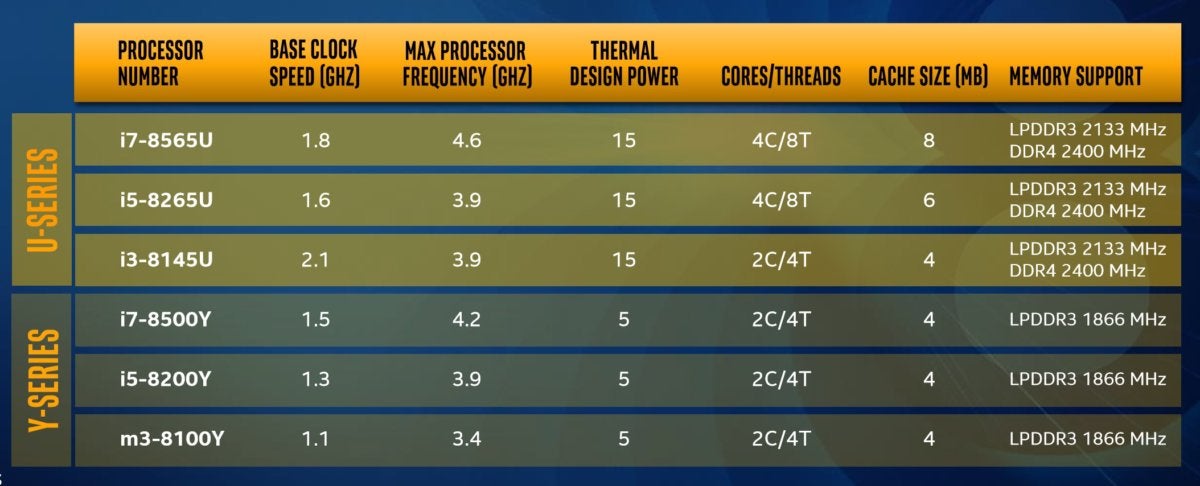 Intel Intel
On paper, Intels 8th-gen Whiskey Lake chips look more attractive. But Intel says design enhancements and other improvements will boost real-world performance higher. The vast majority of Ice Lake chips also start out at extremely low clock speeds, yet can boost to about the levels of their Whiskey Lake counterparts. How long Ice Lake chips can remain in boost mode will help determine their performance. Again, our performance evaluation goes into more detail. While Intels eighth-gen Whiskey Lake chips still emphasized performance increases versus the prior generation, those chips introduced Intels gigabit WiFi and two ports of Thunderbolt 3 I/O. Both have been beefed up, to gigabit+ speeds as well as four Thunderbolt ports. Intel also enhanced its graphics quality as well as its performance, with support for three simultaneous 4K displays at 120Hz, a pair of 5K displays at 60Hz, or a single 8K30 display. The graphics engine includes three display pipes that support DisplayPort 1.4 HBR3 and HDMI 2.08, plus HDR10 and Dolby Vision. Whats next? Project Athena, faster speeds, probably more coresWhat we’ll learn at the end of August about the next chip will also help position Ice Lake. Will that chip introduce an H-series part? Simply flesh out the top end of the “U-series” lineup with a Core i9 offering? Introduce an entirely new lineup? Based on what Senderowitz said about the entirety of the Ice Lake product line, we’d opt for the latter. Apparently the Core i7-1068G7 doesn’t necessarily represent the high end of Intel’s Core offerings for 2019. A six-core, twelve-thread processor almost certainly is in Intel’s future, too. Remember, Ice Lake represents Intel’s first mass-market 10nm processor and its first major redesign in several generations. Even though Intel shipped its first 10nm Cannon Lake chip, the Core i3-8121U, in May 2018, it probably never exceeded extremely low volumes. It’s fair to say, then, that Intel has significant latitude to refine the 10nm process and push up future clock speeds. “I think that you will be able to see how we optimize the workloads...for more segmented and more targeted designs to meet customer needs,” Senderowitz said of what you can expect of Intels future processor positioning.  Intel / YouTube Intel / YouTube
Weve been waiting for a year or so for Project Athena concepts and other designs to arrive, though theyve been designed to make a splash when they do. For now, however, Intel’s betting big on Ice Lake, and you should see numerous thin-and-light and notebook designs built around Intel’s Ice Lake processors this holiday season. Remember, too, that those will include ”Project Athena” designs: flashy “halo” notebooks similar to HP’s Spectre Folio, that try to accomplish bold new things with the next-generation ultrabook form factor. If youre in the market for a notebook PC this holiday season, though, we can already say that youll benefit immensely from knowing what youre buying. We see 2nd- and a few 3rd-gen Ryzen notebooks crowding the low end of the notebook PC market, alongside the 7th- and 8th-gen Core chips that will give way to Ice Lake and its future, faster, cousins. Qualcomm claims that its Snapdragon 8cx offers Core i5-class performance, too. All of that competition can create confusion. But you, as a customer, will ultimately benefit. This story was updated at 9:37 AM to include Intels published processor prices for its 10th-gen Core, Ice Lake chips. Note: When you purchase something after clicking links in our articles, we may earn a small commission. Read our affiliate link policy for more details.
|
|
| ( 心情隨筆|心情日記 ) |





